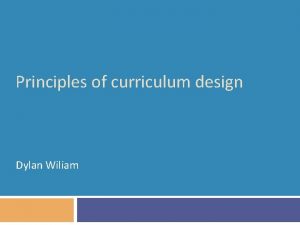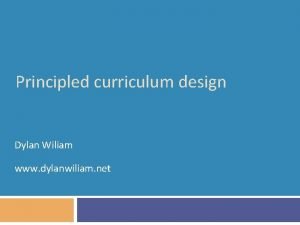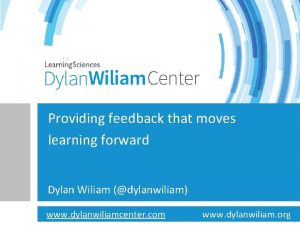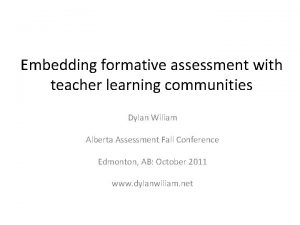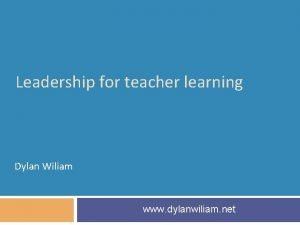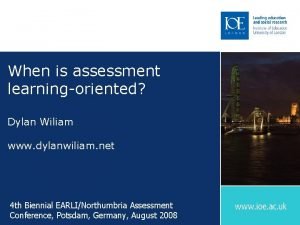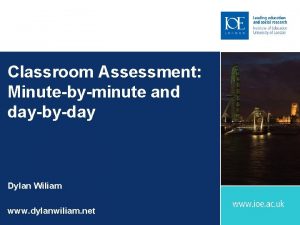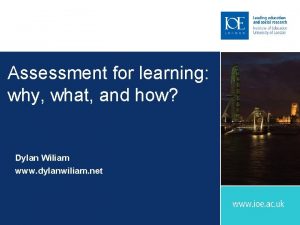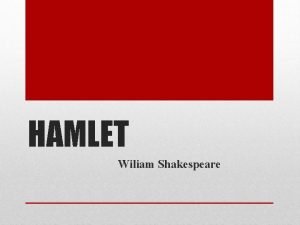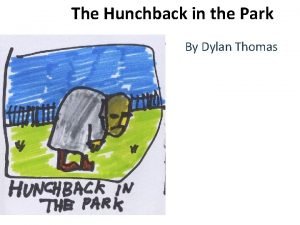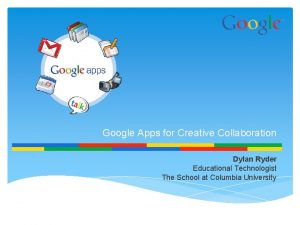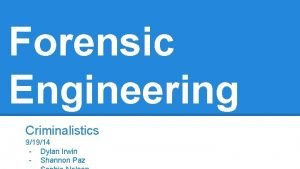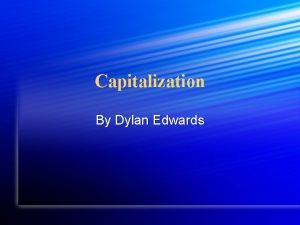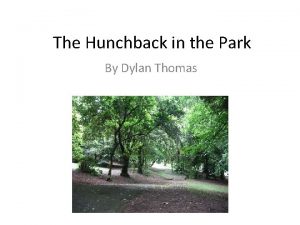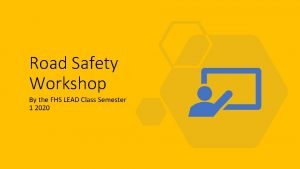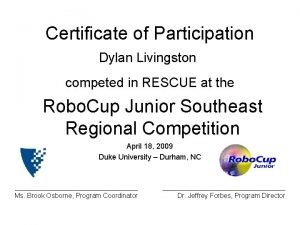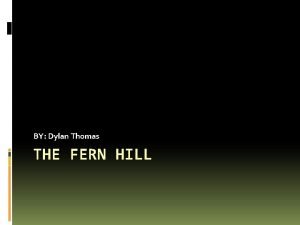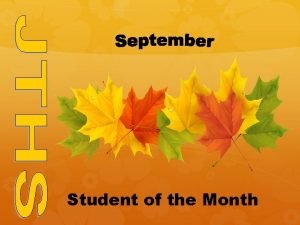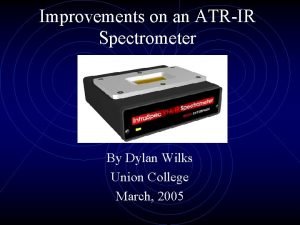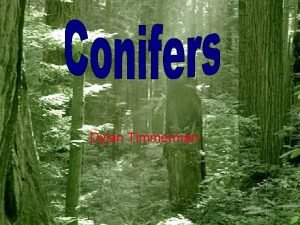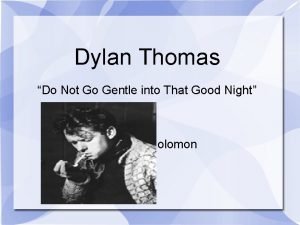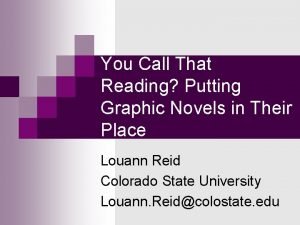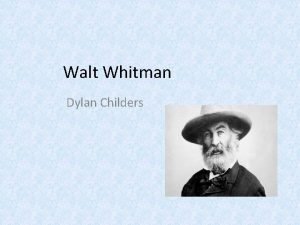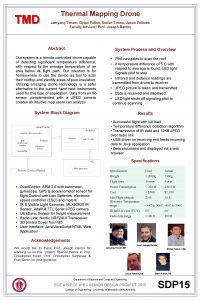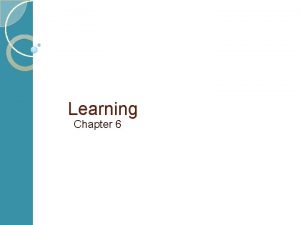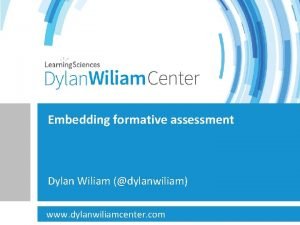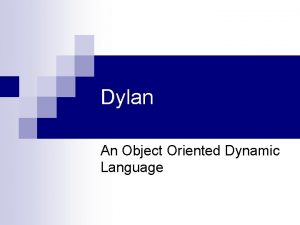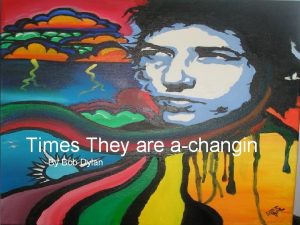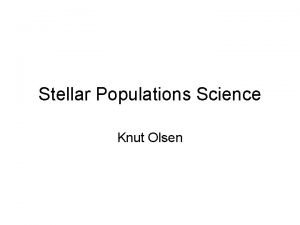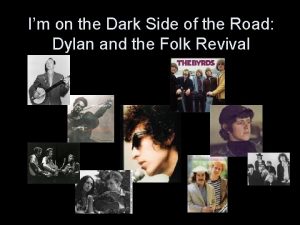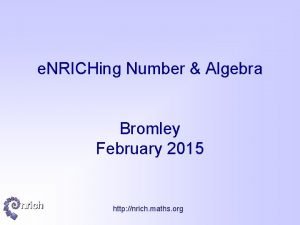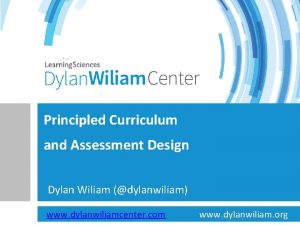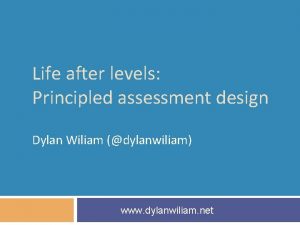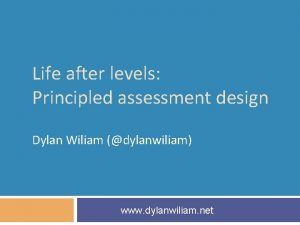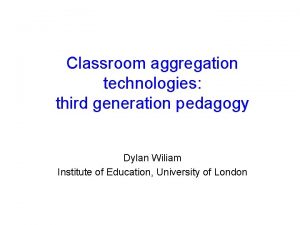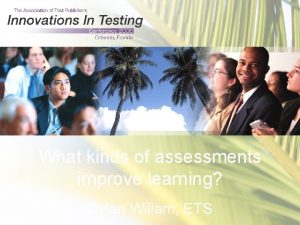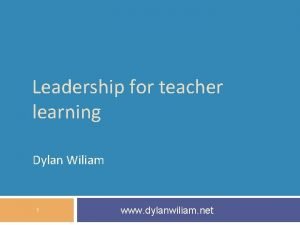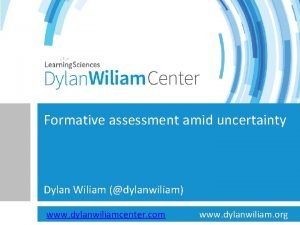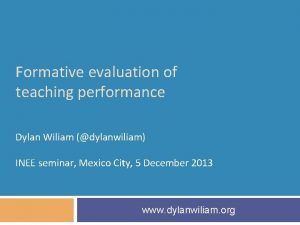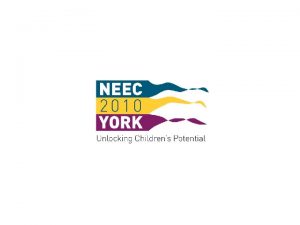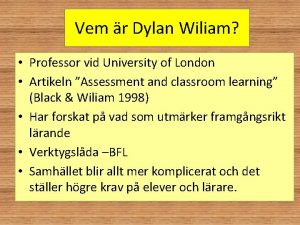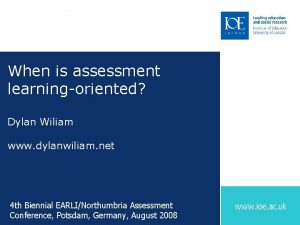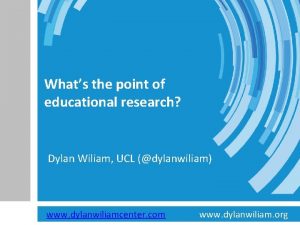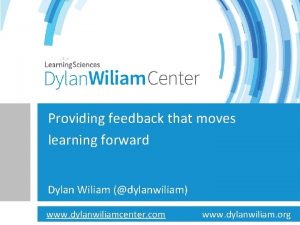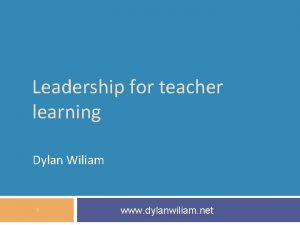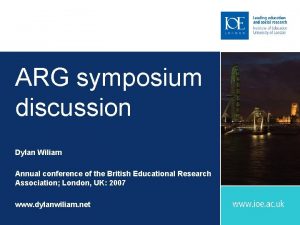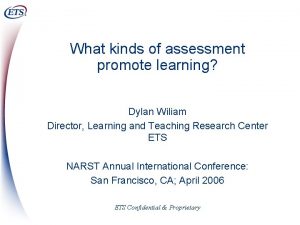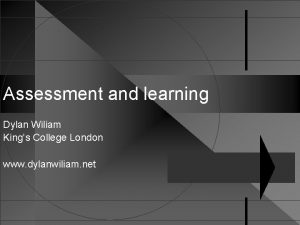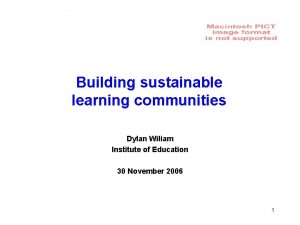Principles of curriculum design Dylan Wiliam Why do





































- Slides: 37

Principles of curriculum design Dylan Wiliam

Why do we educate young people? Broad views on the philosophy of education (Williams, 1961) Transmission of culture (e. g. , Arnold) Preparation for work (e. g. , OECD) Preparation for effective citizenship (e. g. , Freire) Preparation for life 2

Curriculum: an evolving concept The courses taken (Scottish HE, late 17 th century) Four questions (Tyler, 1949) 3 What educational purposes should the school seek to attain? What educational experiences … are likely to attain these purposes? How can these educational experiences be effectively organized? How can we determine whether these purposes are being attained? “All the learning which is planned or guided by the school, whether it is carried on in groups or individually inside or outside the school. ” (Kerr, 1968 p. 16) “the school curriculum (in the wider sense) is essentially a selection from the culture of a society. ” (Lawton, 1975 p. 7)

The role of teachers (Stenhouse, 1975) 4 “A curriculum is an attempt to communicate the essential principles and features of an educational proposal in such a form that it is open to critical scrutiny and capable of effective translation into practice. ” (p. 5)

Question What are your non-negotiable principles as you work on your curriculum review?

Principles of curriculum design A good curriculum is: Balanced Rigorous Coherent Vertically integrated Appropriate Focused/parsimonious Relevant 5

Balanced: which subjects? English Mathematics Science Technology Modern foreign languages Geography History Music Art Physical education Religious education Drama Dance Chess Engineering Geology Astronomy Media studies Law Psychology Sociology Politics 6

Rigorous: subjects, disciplines, or skills? 7 Disciplinary habits of mind are important, specific, powerful ways of thinking that are developed through sustained engagement with the discipline. Mathematics: transformation and invariance History: provenance and context Statistics: dispersion as well as central tendency Sociology: structure and agency

21 st Century skills Cognitive competencies Intra-personal competencies Cognitive processes and strategies Knowledge Creativity Intellectual openness Work ethic/conscientiousness Positive core self-evaluation Inter-personal competencies Team-work Leadership Pellegrino and Hilton (2012) 8

WHAT IS CREATIVITY? What is creativity? What do people mean when they say they have a creative curriculum? 'Creativity is about liberating human energy. ' Howard Gardner 'Creativity is the process of developing ideas that are original and of value. Creative intelligence is dynamic, diverse and distinct. ' Sir Ken Robinson 2001 ‘Imagination is more important than knowledge’ Albert Einstein

CREATIVITY Pupils who are encouraged to think creatively: q become more interested in discovering things for themselves q are more open to new ideas and challenges q are more able to solve problems q can work well with others q become more effective learners q have greater ownership over their learning

Coherent: subjects or themes? 9 Subject-based curricula support disciplines but tend to undermine coherence across different aspects of learning Theme-based curricula support coherence, but tend to undermine disciplinary development

Reading skills: what are they really? 10 A manifold, contained in an intuition which I call mine, is represented, by means of the synthesis of the understanding, as belonging to the necessary unity of self-consciousness; and this is effected by means of the category. What is the main idea of this passage? 1. Without a manifold, one cannot call an intuition ‘mine. ’ 2. Intuition must precede understanding. 3. Intuition must occur through a category. 4. Self -consciousness is necessary to understanding Hirsch (2006)

Lost in translation? 11 Comprehension depends on constructing a mental model that makes the elements fall into place and, equally important, enables the listener or reader to supply essential information that is not explicitly stated. In language use, there is always a great deal that is left unsaid and must be inferred. This means that communication depends on both sides, writer and reader, sharing a basis of unspoken knowledge. This large dimension of tacit knowledge is precisely what is not being taught adequately in our schools. Hirsch (2009 loc. 176)

Reading is complex… Scarborough (2001) 12

Skill is content, content is skill 13 Five propositions about academic skills (Hirsch, 2009) 1 The character of an academic skill is constrained by the limitations of short-term working memory. 2 Academic skills have two components: procedures and contents. 3 Procedural skills such as turning letters into sounds must initially be learned as content, along with other content necessary to higher-order skills. 4 An advance in skill, whether in procedure or content, entails an advance in speed of processing. 5 A higher-order academic skill such as reading comprehension requires prior knowledge of domain-specific content; the higher-order skills for that domain does not readily transfer to other content domains.

21 st Century Learning • Subject knowledge and the understanding that is derived forms one strand • Procedural skills and habits of mind form the other strand • The complimentary base pairings that hold the helix together represent the learners development Knowledge, understanding, subject skills and learner skills are all key. No part is greater than the whole.

14 SOLO taxonomy (Biggs & Collis, 1982) Structure of observed learning outcomes Levels of structure Unistructural Multi-structural Relational Cause and effect in history Single cause Multiple causes Multiple interacting causes

15 Vertically integrated: emphasis on progression In which order would you teach the areas of the following shapes (currently arranged alphabetically)? Parallelogram Rectangle Square Trapezium Triangle

Learning hierarchies 16 Universal Addition before multiplication Natural Multiplication before division Differentiation before integration Arbitrary Areas of triangles before areas of parallelograms Optional The Romans before the Vikings

The spiral curriculum 17 The “spiral curriculum. ” If one respects the ways of thought of the growing child, if one is courteous enough to translate material into his logical forms and challenging enough to tempt him in advance, then it is possible to introduce him at an early age to the ideas and styles that in later life make an educated man. We might ask, as a criterion for any subject taught in primary school, whether, when fully developed, it is worth an adult’s knowing, and whether having known it as a child makes a person a better adult. If the answer to both questions is negative or ambiguous, then the matter is cluttering the curriculum. Bruner (1960 pp. 52 -54; my emphasis)

Kinds of spiral 18 Kinds of spiral Trivial: anything can usefully be revisited Deep: spirals are an important part of a curriculum Inclusion criteria You might need this later You will need this later This is useful now, even if you do not go further You will need this later, and you will be significantly disadvantaged if you do not learn it now

Backward design 19 The tragedy of life is that one can only understand life backwards, but one must live it forwards (Søren Kierkegaard) In the same way, curricula need to be designed backwards, but delivered forwards Should a curriculum be specified in terms of Experiences? Outcomes? Both?

An example of a spiral curriculum Ref. IBO PYP model

Curriculum for excellence: Dance 20 Through dance, learners have rich opportunities to be creative and to experience inspiration and enjoyment. Creating and performing will be the core activities for all learners, and taking part in dance contributes to their physical education and physical activity. Learners develop their technical skills and the quality of their movement, and use their imagination and skills to create and choreograph dance sequences. They further develop their knowledge and understanding and their capacity to enjoy dance through evaluating performances and commenting on their work and the work of others. Scottish Government (2007 p. 5)

Appropriate: 860+570=? 21 Over 5 years, the increase in facility is 75%—an average of 15% per year. In other words, in a class of 30, only four or five children learn this each year. Source: Leverhulme Numeracy Research Programme

Consequences (3) 22

23 Age or stage? Curriculum specified: Year by year By key stage + — Supports coherence across subjects Restricts freedom for teachers to plan different sequences Encourages “highreliability” teaching Promotes (requires? ) atomisation of curriculum Allows teachers to plan different sequences Difficult to ensure strong cross curricular links Encourages a focus on ‘big ideas’ Allows unnecessary differentiation

Key Questions/issues/ideas…. What questions/issues/ideas does Dylan raise for you? . . How can you retain ‘big ideas’ in a year by year approach? What MUST be taught chronologically, sequentially and ‘year by year’? Keeping the class together – how? Why?

Focused: Successful education 24 The test of successful education is not the amount of knowledge that a pupil takes away from school, but his appetite to know and his capacity to learn. If the school sends out children with the desire for knowledge and some idea how to acquire and use it, it will have done its work. Too many leave school with the appetite killed and the mind loaded with undigested lumps of information. The good schoolmaster is known by the number of valuable subjects that he declines to teach. Livingstone (1941 p. 28)

Big ideas of science (Harlen, 2011) 1 2 3 4 5 6 7 8 9 10 25 All material in the Universe is made of very small particles. Objects can affect other objects at a distance. Changing the movement of an object requires a net force acting on it. The total amount of energy in the Universe is always the same but energy can be transformed when things change or are made to happen. The composition of the Earth and its atmosphere and the processes occurring within them The solar system is a very small part of one of millions of galaxies in the Universe. Organisms are organised on a cellular basis. Organisms require a supply of energy and materials for which they are often dependent on or in competition with other organisms. Genetic information is passed from one generation of organisms to another. The diversity of organisms, living and extinct, is the result of evolution.

Big ideas about science (Harlen, 2011) 26 1 2 Science assumes that for every effect there is one or more causes. 3 The knowledge produced by science is used in some technologies to create products to serve human ends. 4 Applications of science often have ethical, social, economic and political implications. Scientific explanations, theories and models are those that best fit the facts known at a particular time.

Relevant: informed choice About what to learn (Curriculum) About how to learn (Pedagogy) Degree of choice should be influenced by 27 Consequences (for the individual and for society) Maturity Consequences of choices (and especially poor choices) about what is to be learned are generally greater than choices about how learning should be achieved, so For younger learners, many if not most learning outcomes need to be nonnegotiable. As they get older their wishes should become predominate their interests (progressive lowering of the “safety net”) From the earliest age, however, learners should be involved in decisions about how they learn best.

Informed choice about curriculum • Intrinsic factors – – • Extrinsic factors – – • What is the subject really like? Authenticity of experience Habits of mind Developing identity (e. g. , mathematics, plumbing) “Critical filters” for particular careers Financial rewards Consequences – – Closing down of options (“leaky pipes”) Sensitive periods 28

Informed choice in mathematics 29 Goldbach’s conjecture Euler’s relation F + V = E + 2 The alternating harmonic series Torricelli’s trumpet

Principles of curriculum design • A good curriculum is: • • Balanced Rigorous Coherent Vertically integrated Appropriate Focused/parsimonious Relevant 30

References Biggs, J. B. , & Collis, K. F. (1982). Evaluating the quality of learning: the SOLO taxonomy (structure of the observed learning outcome). London, UK: Academic Press. Bruner (1960 pp. 52 -54; my emphasis). The Process of Education, Cambridge, MA: Harvard University Press, pp. 52 -54 (my emphasis). Harlen, W. (Ed. ). (2010). Principles and big ideas of science education. Hatfield, UK: Association for Science Education. Hirsch, E. D. (2006, 26 April). Readingcomprehension skills? What are they really? Education Week, 25, 57, 42. Hirsch Jr. , E. D. (2009). The making of Americans: democracy and our schools. New Haven, CT: Yale University Press. Kerr, J. F. (1968). The problem of curriculum reform. In J. F. Kerr (Ed. ), Changing the curriculum (pp. 13 -38). London, UK: University of London Press. Lawton, D. L. (1975). Class, culture and the curriculum. London, UK: Routledge and Kegan Paul. 31 Livingstone, R. W. (1941). The future in education. Cambridge, UK: Cambridge University Press. Pellegrino, J. W. , & Hilton, M. L. (Eds. ). (2012). Education for life and work: Developing transferable knowledge and skills in the 21 st Century. Washington, DC: National Academies Press. Scarborough, H. (2001). Connecting early language and literacy to later reading (dis)abilities: evidence, theory and practice. In S. B. Neuman & D. K. Dickinson (Eds. ), Handbook of early literacy research (Vol. 1, pp. 97 -110). New York, NY: Guilford Press. Scottish Government (2007). Curriculum for Excellence: expressive arts experiences and outcomes. Edinburgh, UK: Scottish Government. Stenhouse, L. (1975). An introduction to curriculum research and development. London, UK: Heinemann. Tyler, R. W. (1949). Basic principles of curriculum and instruction. Chicago, IL: University of Chicago Press. Williams, R. (1961). The long revolution. London, UK: Chatto & Windus.
 Dylan wiliam curriculum
Dylan wiliam curriculum Principled curriculum design
Principled curriculum design Moving learning games forward
Moving learning games forward Dylan wiliam teacher learning communities
Dylan wiliam teacher learning communities Tlc dylan wiliam
Tlc dylan wiliam Dylan wiliam learning intentions
Dylan wiliam learning intentions Tlc dylan wiliam
Tlc dylan wiliam Dylan wiliam formative assessment
Dylan wiliam formative assessment Why why why why
Why why why why Hamlet mjesto radnje
Hamlet mjesto radnje Don't ask why why why
Don't ask why why why Elements and principles of design ppt
Elements and principles of design ppt How does the poet picture that the hunchback is homeless?
How does the poet picture that the hunchback is homeless? Dylan ryder social media
Dylan ryder social media Dylan irwin
Dylan irwin Urheber
Urheber Dylan edwards on3
Dylan edwards on3 Hunchback in the park
Hunchback in the park Apexa login
Apexa login Dylan briggs accident frankston
Dylan briggs accident frankston Dylan bromley
Dylan bromley Dylan livingston
Dylan livingston Fern hill by dylan thomas summary
Fern hill by dylan thomas summary Dylan terpstra
Dylan terpstra Wilks ir
Wilks ir Dylan timmerman
Dylan timmerman Dylan thomas wikipedia
Dylan thomas wikipedia Dylan horrocks hicksville
Dylan horrocks hicksville Dylan whitman
Dylan whitman Dylan fallon
Dylan fallon Bob dylan
Bob dylan Dylan's mother buys him a sailor's cap
Dylan's mother buys him a sailor's cap What is the aera
What is the aera Dylan programming language
Dylan programming language The times they are a-changin'
The times they are a-changin' Dylan knut olsen bokvist
Dylan knut olsen bokvist Bob dylan dark side of the road
Bob dylan dark side of the road Nrich what's it worth
Nrich what's it worth
